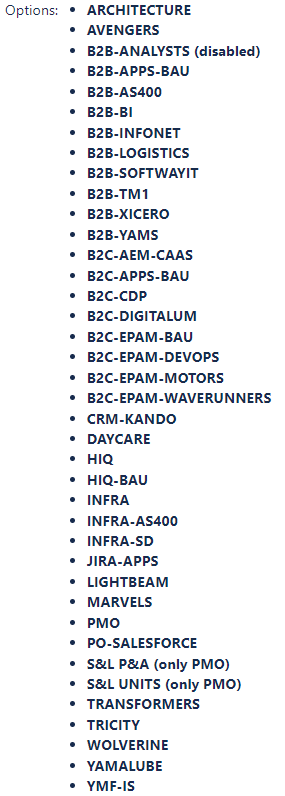Page History
...
- Type: Issue type used
- Priority: By default issues are set to Medium
- Affected Version/s: field is by default empty, can be filled with affected version/s used for releases.
- Business value: used to estimate (in a Fibonacci range) the value of that piece of development to the YME business.
Labels: tags or keywords that can be added to issues to show whether they possess certain characteristics. If a issue is related to BAU (Business As Usual) activities labels label BAU is added.
Epic Link: link to epic issue(s) (large feature).
- Sprint: Multi select field to link the issue to a sprint.
- Requirement status: The requirement test status by version or test plan, is used by XRAY and applicable for issue type Story and Change request.
- Solution Group : This field is used to select a single department. Based upon this field the ticket will appear in the queue of a department.
Application-Module: Select list of applications (products) and modules (programs).
- Yamaha Team: Yamaha Team is a single select drop down field which is required for all issue types used in YIS.
This field includes all teams that exist within YME Information Services. When a new team is founded, an entry is added to this field.
For example, the entries on 01/01/2023:
Any team board uses this field to filter on, so it's mandatory to fill in at ticket creation, so that the item will show up on the correct team board.
N.B.: In the past a free text field "Team Yamaha" was used, in which typing errors caused for tickets to get lost. This old field is in the process of being phased out, so you may still see it on certain screens.
- Target release date: is used to track the intended release date aligned with stakeholders.
- Ticket groups: Used to group stories and bugs under a YPM Programme.
Story Points: used for issue estimation and tracking progress of workto estimate the complexity, effort, and risk inherent to the story. Story Points field available for issue type Epic, Change request, Task, Story, Bug, Defect, Spike
- DOR: DOR is the abbreviation forDefinition of Ready. Scrum teams generally use a Definition of Ready to clarify whether a Jira issue (Product Backlog Item, or PBI) can be taken into sprint. Within Jira, this process has been summarized in a field, "DoR", which allows tracking what an issue needs to become ready for development.
The generalized DoR steps are:
1. PBI created
2. User Story defined
3. Acceptance criteria defined
4. Refinement & estimation done
5. Ready for sprint
N.B. This is an optional feature. Set the field manually in refinement sessions, in case that makes sense for your team. - DoD projects: A Definition of Done (DoD) is a term from the scrum framework, which describes the agreement of what it means when an item is set to "Done" status.
Within YME the intent it to validate these three organization-wide requirements for each ticket, because YME is being audited on these three points. For this reason, it is expected that this field will become mandatory across all YME projects in Jira.
When closing a Story, Bug or Defect, it is mandatory to full the field "DoD projects": - Installation instructions: used by some teams to store details for deployment, for example if configuration is required on production system. Optional field.
- Status: Workflow status summary.
- Resolution: Resolution can be is set automatically when a an issue will be is closed.
- Fix/version: Mandatory field field used to assign completed developments to a a release scheduled to go to production.
Additionally, on Kanban boards, closed items will disappear from the board once a fix/version is closed, not earlier.
...
- Backlog: work has not started;
- In progress: a developer builds & unit tests their own work to meet acceptance criteria;
- Review: a peer reviews any code & functionality;
- Ready for test: waiting for a QA officer;
- In test: QA officer is performing integration test & regression test;
- In UAT: PO/business validate that the functionality is as required, or provide feedback;
- Done: the work is completed without deployment needed; or
- Ready for deployment: the the work is done & documented, but deployment to production is needed;
- Scheduled for deployment: deployment deployment date is set;
- Done deployment: the solution is available and working on production.
The steps in italics are shown on the deployment board, while "Ready for Deployment" is the final state on development boards.
Any issue-type that will not include a deployment uses the simplified "Four-step" workflow:
...








